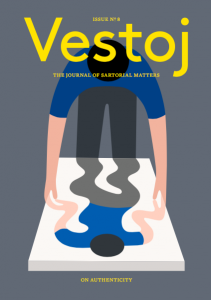
BEFORE OUR MEETING I wait on a designed and uncomfortable chair in the reception area of the big conglomerate that owns the company he works for a few days a week. The wall-to-wall carpet is grey and everything else white, bar the receptionist in black. Silence reigns. The experience is a bit like being in an upscale dentist’s waiting room at an imaginary space station, if it were used as the backdrop for a fashion shoot. It’s minimal and, I assume, intended to be both impressive and somewhat intimidating. When I’m taken to meet him, his appearance is a welcome respite to all the high status monochrome, albeit a studied one. He looks relaxed, though he’s just six days away from one of his high profile womenswear shows, and hardly any fabrics have turned up yet. We talk until his PA signals that it’s time to escort me out.
***
I change styles all the time. Yesterday I was dressed as a goth and today I’m wearing vintage because it’s what I felt like when I woke up this morning. I’m a bit of a borderline person so I need to have options or else I’d get bored. Not long ago I was stopped by the police at Gare du Nord, coming back from Brussels with my boyfriend. We’d been to a Sisters of Mercy concert and were dressed like metalheads because that’s how you dress to those kind of concerts. I was wearing platform New Rocks and a lot of black, and we were both searched for almost an hour, for drugs and for terrorism. We were singled out because of the way we looked. I remember back in the early days of Vetements, when I was still into partying I used to dress in security uniforms, which are really easy to get anywhere in the world – you don’t need a license. I’d dress in boots, a T-shirt with ‘Security’ printed on it and bomber jackets. I never had to queue and I never paid for a single party. I just walked right in. So the question is, does changing my style all the time make me inauthentic? I don’t think so; I think it’s the opposite. Every way I dress is me, but I also play a role. If anyone else wore what I am wearing today, he’d probably be working in a supermarket or in construction. People don’t expect me, as a fashion designer, to dress the way I do.
I like playing roles; it makes me feel safe. Authenticity for me perhaps means something different than for most people. I don’t have one interpretation of authenticity when it comes to style; I like moving between them. When I wear a sweatshirt with ‘Monoprix’ on it, what am I signalling? Am I saying it’s cool to work at a supermarket or am I making people ask themselves why I’m wearing a Monoprix logo, when I could be wearing one from Balenciaga? Well, you tell me. Obviously everybody knows that I don’t work at Monoprix, well everyone who knows me does anyway. If a stranger sees me in the street wearing my Monoprix jumper, they might think I really do work there and I quite like that. Because of my physique I tend to go for the security outfit or the supermarket logo rather than, say, a Brooks Brothers suit; certain roles feel closer to me than others. If I had an alternative life, I’d see myself working as a cashier before I saw myself working in a bank.
Authenticity is something very personal, it’s hard to define what it means in general. I think about this now when so much of the information disseminated online has to do with numbers. Finding what appeals to the most people, most of the time. To me, authenticity can be the fabric you choose to make a parka: a military parka is authentic in a khaki washed cotton. If you do it in denim, it’s not authentic. Authenticity is about going back to the original archetype. Every garment I do is based on a garment that already exists; I don’t invent anything new. Well, apart from the legging that turned into a pump that I did recently at Balenciaga and called ‘pantashoe.’ But typically I would use the term ‘authenticity’ to describe something I can associate to something from my past experience. Take the trench: for me there is only one image in my mind when I think of that garment and it’s Meryl Streep in a movie from the eighties, standing on the Manhattan Bridge.
In January 2017 I put on a Vetements fashion show that was all based on archetypes of dressing; that show was a revelation for me. A lot of people, or rather a lot of fashion people I talked to afterwards thought it was too simple. Not fashion enough. And that’s even though the collection included forty-five different design concepts, like a wedding dress as a jogging suit. In most collections you have one concept – like, this season the concept is ‘Greece’ and the whole collection is about Grecian goddesses. I had forty-five, and still fashionistas found it simple. They found it simple because my trench coats were beige, or because a model in jeans and a shirt reminded them of a neighbour. To me, that was the whole purpose of the show. I had to explain things afterwards. It wasn’t about normcore at all, it was highly conceptual. The trench coat was lined with a dress that you can also wear, but you have to put it on to know that. But everyone was watching the show through their phones so how could they tell what the collection was really about?
Both the Balenciaga and Vetements client is a very well-informed person: they know about the brands, and even when new products are coming out. It’s quite surprising and fascinating to me, how much they know and care. If I wasn’t working in fashion, I don’t think I would ever spend so much time on it. For the Vetements client, it’s all about attitude, you know, grunge and greasy hair. It’s still a bit underground. Balenciaga has a very different take on conceptual design in terms of construction, shape, volume. Wearing either brand is a social signal too – it says that you’re in the right fashion clique. In any period of fashion history, there are always a few brands that best signify the times, brands that those in the know feel they should be wearing. In the nineties, it was Helmut Lang and Margiela, and now it’s this. You wear your Vetements or Balenciaga with Acne shoes and Céline sunglasses, and you’re it – that’s how they function in their fashion minds. It’s funny actually, since I dress both the Vetements and Balenciaga customer, my client base as ‘Demna Gvasalia’ is much bigger than either one brand. I’ve become a brand too, sort of.
I went to buy a jogging outfit the other day but to me all those brands have zero authenticity – they all look the same, just with different logos. They invest all this money in authentic image and branding but what they produce has no authenticity. To really be authentic you have to be able to recognise the products of one brand from another. It has to be unique. Identifiable. Logos are the easiest way to brand something, it’s a little lazy even. We did it a lot at Vetements at the beginning, and many of those products are still in demand so we keep producing them. I was experimenting with an almost shameless idea of branding, and it really worked. It’s a way of communicating that’s very adapted to the internet era: you can see immediately where a garment is from if it has a logo. It has a visual immediacy that’s easily instagrammable. At Balenciaga I’ve used logos almost to identify this new era for the brand; it’s like a stamp that authenticates a garment as a ‘Balenciaga by Demna Gvasalia’ piece. When I design a piece, my last thought is always, ‘Does this need a logo?’ Generally though, we do logos less and less – I’m too tired and bored of it now. I’m really into the idea of storytelling today. I know it’s an old school way to work in fashion, but since I’ve always focused on wardrobe categories, the products I make coexist but don’t necessarily interact. Working with a story would unite all the elements in a collection, and that’s unknown territory for me. I’ll work with real characters, actual people who are inspirational to me for a particular collection.
I think about the dangers of selling out every day. You can’t saturate the market. It’s so easy today to get caught in the sell-out trap, especially when a business is successful and a product is in demand. When something becomes popular, buyers want to get more of it and are willing to invest a higher budget in your brand in order to make more pro t from it. But you get to the point of oversaturation too easily: you produce too many hoodies and T-shirts and soon people don’t want it anymore and it goes on sale. We’ve had to deal with this kind of situation a lot at Vetements and we’re only now beginning to understand how to strategise and manage this in the future. We’re reducing the supply: it’s a very basic market economy model. When buyers say, ‘We want to give you more money,’ you say no. But that’s the most difficult thing for a company, whether it’s new or old. No one wants to refuse money. Many brands destroy themselves because they can’t say no. Thanks goodness I’ve had four years of economic education, so I always balance up the risks. You have to believe in your own long-term strategy, even if it leads to you losing money in the short run. To resist, you need stamina.

Anja Aronowsky-Cronberg is Vestoj’s editor-in-chief and founder.
Denis Darzacq is a photographer living and working in Paris. His series, Hyper, captures street dancers in supermarkets.
This article was originally published in Vestoj: On Authenticity, available for purchase here.

